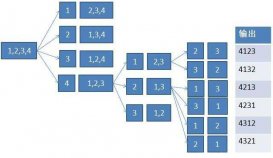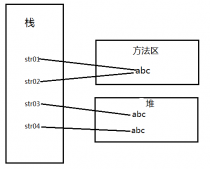一. 线程池简介
1. 线程池的概念:
线程池就是首先创建一些线程,它们的集合称为线程池。使用线程池可以很好地提高性能,线程池在系统启动时即创建大量空闲的线程,程序将一个任务传给线程池,线程池就会启动一条线程来执行这个任务,执行结束以后,该线程并不会死亡,而是再次返回线程池中成为空闲状态,等待执行下一个任务。
2. 线程池的工作机制
2.1 在线程池的编程模式下,任务是提交给整个线程池,而不是直接提交给某个线程,线程池在拿到任务后,就在内部寻找是否有空闲的线程,如果有,则将任务交给某个空闲的线程。
2.2 一个线程同时只能执行一个任务,但可以同时向一个线程池提交多个任务。
3. 使用线程池的原因:
多线程运行时间,系统不断的启动和关闭新线程,成本非常高,会过渡消耗系统资源,以及过渡切换线程的危险,从而可能导致系统资源的崩溃。这时,线程池就是最好的选择了。
二. 四种常见的线程池详解
1. 线程池的返回值executorservice简介:
executorservice是java提供的用于管理线程池的类。该类的两个作用:控制线程数量和重用线程
2. 具体的4种常用的线程池实现如下:(返回值都是executorservice)
2.1 executors.newcachethreadpool():可缓存线程池,先查看池中有没有以前建立的线程,如果有,就直接使用。如果没有,就建一个新的线程加入池中,缓存型池子通常用于执行一些生存期很短的异步型任务
示例代码:
|
1
2
3
4
5
6
7
8
9
10
11
12
13
14
15
16
17
18
19
20
21
22
23
|
package com.study.test;import java.util.concurrent.executorservice;import java.util.concurrent.executors;public class threadpoolexecutortest { public static void main(string[] args) { //创建一个可缓存线程池 executorservice cachedthreadpool = executors.newcachedthreadpool(); for (int i = 0; i < 10; i++) { try { //sleep可明显看到使用的是线程池里面以前的线程,没有创建新的线程 thread.sleep(1000); } catch (interruptedexception e) { e.printstacktrace(); } cachedthreadpool.execute(new runnable() { public void run() { //打印正在执行的缓存线程信息 system.out.println(thread.currentthread().getname()+"正在被执行"); } }); } }} |
输出结果:
pool-1-thread-1正在被执行
pool-1-thread-1正在被执行
pool-1-thread-1正在被执行
pool-1-thread-1正在被执行
pool-1-thread-1正在被执行
pool-1-thread-1正在被执行
pool-1-thread-1正在被执行
pool-1-thread-1正在被执行
pool-1-thread-1正在被执行
pool-1-thread-1正在被执行
线程池为无限大,当执行当前任务时上一个任务已经完成,会复用执行上一个任务的线程,而不用每次新建线程
2.2 executors.newfixedthreadpool(int n):创建一个可重用固定个数的线程池,以共享的无界队列方式来运行这些线程。
示例代码:
|
1
2
3
4
5
6
7
8
9
10
11
12
13
14
15
16
17
18
19
20
21
22
|
package com.study.test;import java.util.concurrent.executorservice;import java.util.concurrent.executors;public class threadpoolexecutortest { public static void main(string[] args) { //创建一个可重用固定个数的线程池 executorservice fixedthreadpool = executors.newfixedthreadpool(3); for (int i = 0; i < 10; i++) { fixedthreadpool.execute(new runnable() { public void run() { try { //打印正在执行的缓存线程信息 system.out.println(thread.currentthread().getname()+"正在被执行"); thread.sleep(2000); } catch (interruptedexception e) { e.printstacktrace(); } } }); } }} |
输出结果:
pool-1-thread-1正在被执行
pool-1-thread-2正在被执行
pool-1-thread-3正在被执行
pool-1-thread-1正在被执行
pool-1-thread-2正在被执行
pool-1-thread-3正在被执行
pool-1-thread-1正在被执行
pool-1-thread-2正在被执行
pool-1-thread-3正在被执行
pool-1-thread-1正在被执行
因为线程池大小为3,每个任务输出打印结果后sleep 2秒,所以每两秒打印3个结果。
定长线程池的大小最好根据系统资源进行设置。如runtime.getruntime().availableprocessors()
2.3 executors.newscheduledthreadpool(int n):创建一个定长线程池,支持定时及周期性任务执行
延迟执行示例代码:
|
1
2
3
4
5
6
7
8
9
10
11
12
13
14
15
16
|
package com.study.test;import java.util.concurrent.executors;import java.util.concurrent.scheduledexecutorservice;import java.util.concurrent.timeunit;public class threadpoolexecutortest { public static void main(string[] args) { //创建一个定长线程池,支持定时及周期性任务执行——延迟执行 scheduledexecutorservice scheduledthreadpool = executors.newscheduledthreadpool(5); //延迟1秒执行 scheduledthreadpool.schedule(new runnable() { public void run() { system.out.println("延迟1秒执行"); } }, 1, timeunit.seconds); }} |
输出结果:
延迟1秒执行
定期执行示例代码:
|
1
2
3
4
5
6
7
8
9
10
11
12
13
14
15
16
|
package com.study.test;import java.util.concurrent.executors;import java.util.concurrent.scheduledexecutorservice;import java.util.concurrent.timeunit;public class threadpoolexecutortest { public static void main(string[] args) { //创建一个定长线程池,支持定时及周期性任务执行——定期执行 scheduledexecutorservice scheduledthreadpool = executors.newscheduledthreadpool(5); //延迟1秒后每3秒执行一次 scheduledthreadpool.scheduleatfixedrate(new runnable() { public void run() { system.out.println("延迟1秒后每3秒执行一次"); } }, 1, 3, timeunit.seconds); }} |
输出结果:
延迟1秒后每3秒执行一次
延迟1秒后每3秒执行一次
.............
2.4 executors.newsinglethreadexecutor():创建一个单线程化的线程池,它只会用唯一的工作线程来执行任务,保证所有任务按照指定顺序(fifo, lifo, 优先级)执行。
示例代码:
|
1
2
3
4
5
6
7
8
9
10
11
12
13
14
15
16
17
18
19
20
21
22
23
|
package com.study.test;import java.util.concurrent.executorservice;import java.util.concurrent.executors;public class testthreadpoolexecutor { public static void main(string[] args) { //创建一个单线程化的线程池 executorservice singlethreadexecutor = executors.newsinglethreadexecutor(); for (int i = 0; i < 10; i++) { final int index = i; singlethreadexecutor.execute(new runnable() { public void run() { try { //结果依次输出,相当于顺序执行各个任务 system.out.println(thread.currentthread().getname()+"正在被执行,打印的值是:"+index); thread.sleep(1000); } catch (interruptedexception e) { e.printstacktrace(); } } }); } }} |
输出结果:
pool-1-thread-1正在被执行,打印的值是:0
pool-1-thread-1正在被执行,打印的值是:1
pool-1-thread-1正在被执行,打印的值是:2
pool-1-thread-1正在被执行,打印的值是:3
pool-1-thread-1正在被执行,打印的值是:4
pool-1-thread-1正在被执行,打印的值是:5
pool-1-thread-1正在被执行,打印的值是:6
pool-1-thread-1正在被执行,打印的值是:7
pool-1-thread-1正在被执行,打印的值是:8
pool-1-thread-1正在被执行,打印的值是:9
三. 缓冲队列blockingqueue和自定义线程池threadpoolexecutor
1. 缓冲队列blockingqueue简介:
blockingqueue是双缓冲队列。blockingqueue内部使用两条队列,允许两个线程同时向队列一个存储,一个取出操作。在保证并发安全的同时,提高了队列的存取效率。
2. 常用的几种blockingqueue:
- arrayblockingqueue(int i):规定大小的blockingqueue,其构造必须指定大小。其所含的对象是fifo顺序排序的。
- linkedblockingqueue()或者(int i):大小不固定的blockingqueue,若其构造时指定大小,生成的blockingqueue有大小限制,不指定大小,其大小有integer.max_value来决定。其所含的对象是fifo顺序排序的。
- priorityblockingqueue()或者(int i):类似于linkedblockingqueue,但是其所含对象的排序不是fifo,而是依据对象的自然顺序或者构造函数的comparator决定。
- synchronizedqueue():特殊的blockingqueue,对其的操作必须是放和取交替完成。
3. 自定义线程池(threadpoolexecutor和blockingqueue连用):
自定义线程池,可以用threadpoolexecutor类创建,它有多个构造方法来创建线程池。
常见的构造函数:threadpoolexecutor(int corepoolsize, int maximumpoolsize, long keepalivetime, timeunit unit, blockingqueue<runnable> workqueue)
示例代码:
|
1
2
3
4
5
6
7
8
9
10
11
12
13
14
15
16
17
18
19
20
21
22
23
24
25
26
27
28
29
30
31
32
33
34
35
36
37
38
39
40
41
42
|
package com.study.test;import java.util.concurrent.arrayblockingqueue;import java.util.concurrent.blockingqueue;import java.util.concurrent.threadpoolexecutor;import java.util.concurrent.timeunit;class tempthread implements runnable { @override public void run() { // 打印正在执行的缓存线程信息 system.out.println(thread.currentthread().getname() + "正在被执行"); try { // sleep一秒保证3个任务在分别在3个线程上执行 thread.sleep(1000); } catch (interruptedexception e) { e.printstacktrace(); } } }public class testthreadpoolexecutor { public static void main(string[] args) { // 创建数组型缓冲等待队列 blockingqueue<runnable> bq = new arrayblockingqueue<runnable>(10); // threadpoolexecutor:创建自定义线程池,池中保存的线程数为3,允许最大的线程数为6 threadpoolexecutor tpe = new threadpoolexecutor(3, 6, 50, timeunit.milliseconds, bq); // 创建3个任务 runnable t1 = new tempthread(); runnable t2 = new tempthread(); runnable t3 = new tempthread(); // runnable t4 = new tempthread(); // runnable t5 = new tempthread(); // runnable t6 = new tempthread(); // 3个任务在分别在3个线程上执行 tpe.execute(t1); tpe.execute(t2); tpe.execute(t3); // tpe.execute(t4); // tpe.execute(t5); // tpe.execute(t6); // 关闭自定义线程池 tpe.shutdown(); }} |
输出结果:
pool-1-thread-1正在被执行
pool-1-thread-2正在被执行
pool-1-thread-3正在被执行
总结
以上就是这篇文章的全部内容了,希望本文的内容对大家的学习或者工作具有一定的参考学习价值,谢谢大家对服务器之家的支持。如果你想了解更多相关内容请查看下面相关链接
原文链接:https://blog.csdn.net/hnd978142833/article/details/80253784
















